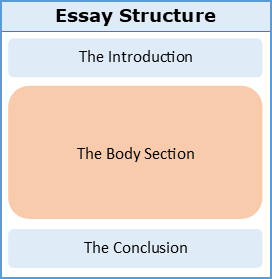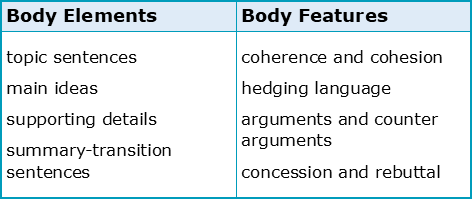What is the body section of an academic essay?

This is the first of four chapters About Body Paragraphs. To complete this reader, read each chapter carefully and then unlock and complete our materials to check your understanding.
– Introduce the concept of introduction, body and conclusion sections and how they are used in essays
– Discuss the purpose of a body section in an academic essay
– Highlight some of the key elements and features of a successful body paragraph
Before you begin reading...
-
video and audio texts
-
knowledge checks and quizzes
-
skills practices, tasks and assignments
Chapter 1

Writing a successful essay takes considerable skill and practice, and the body section of any essay is of critical importance. To complete a bachelor’s or master’s degree, students around the world will be required to carefully plan, construct, write, edit and proofread essays of various lengths about various topics, and to do that successfully usually requires a confident understanding of the formula that makes for a clear, concise and effective essay. This short introductory reader therefore aims to introduce students to the overall concept and purpose of body paragraphs (Chapter 1), discuss the elements that build them (Chapter 2), highlight the phrases that help their navigation (Chapter 3), and provide the best tips for making an essay’s body convincing for the reader (Chapter 4).
Do essays have different sections?
While there might be a wide variety of different essay types for students to learn (cause-and-effect, compare-and-contrast, theses, dissertations, etc.) almost any of these essays can be divided into three key sections: the introduction, the body, and the conclusion:

As can be seen in this diagram, the body section, which may be comprised of many different paragraphs, forms the main bulk of any essay (usually about 70%). As a general rule, any paragraph that comes between the introduction and the conclusion is a body paragraph that forms part of the body section. While an essay’s introduction and conclusion can be more generic and easier to write, the body section is the most varied and complex aspect, taking the most practice and time.
Does the body section have purpose?
If the introduction provides the topic and focus of the essay and its variables, and the conclusion summarises its findings and key arguments, the body section is where the topic is discussed and explored – where philosophical battles are fought and won. The body section is purposeful but variable, as it is the precise purpose of the essay that determines the purpose of the body paragraph. If, for example, you are asked to write an evaluative essay, then the purpose of your essay’s body section would be to provide sufficient evaluation (both sides of the argument) for a given topic; likewise, the problems and solutions of a problem-solution essay would be explored in that essay’s body section, as would the causes and effects of a specific situation in a cause-and-effect essay.
What makes a body section successful?
Because of the variation inherent in the body of an essay, students will not be able to find or memorise a sure-fire formula that achieves academic success. Subjectively speaking, the best essays can in fact be the ones that do not follow any prescribed pattern, instead being those which are compelling, well-research and well argued. Nevertheless, and as the following three chapters will demonstrate, there are a number of essay elements and features that when successfully included should greatly increase the success of any academic essay. These elements and features are summarised in the table below, with more detail provided in Chapter 2:


To reference this reader:
Academic Marker (2022) About Body Paragraphs. Available at: https://academicmarker.com/essay-writing/body-paragraphs/about-body-paragraphs/ (Accessed: Date Month Year).
Downloadables
Once you’ve completed all four chapters in this short reader About Body Paragraphs, you might then wish to download our Chapter Worksheets to check your progress or print for your students. These professional PDF worksheets can be easily accessed for only a few Academic Marks
Chapter 1 explores the topic: What is the body section of an academic essay? Our Chapter 1 Worksheet (containing guidance, activities and answer keys) can be accessed here at the click of a button.
Chapter 2 explores the topic: Which elements build successful body paragraphs? Our Chapter 2 Worksheet (containing guidance, activities and answer keys) can be accessed here at the click of a button.
Chapter 3 explores the topic: Which academic phrases belong in an essay body? Our Chapter 3 Worksheet (containing guidance, activities and answer keys) can be accessed here at the click of a button.
Chapter 4 explores the topic: Which tips make for effective essay body sections? Our Chapter 4 Worksheet (containing guidance, activities and answer keys) can be accessed here at the click of a button.
To save yourself 3 Marks, click on the button below to gain unlimited access to all of our About Body Paragraphs Chapter Worksheets. This All-in-1 Pack includes every chapter, activity and answer key related this topic in one handy and professional PDF.
Collect Academic Marks
-
100 Marks for joining
-
25 Marks for daily e-learning
-
100-200 for feedback/testimonials
-
100-500 for referring your colleages/friends